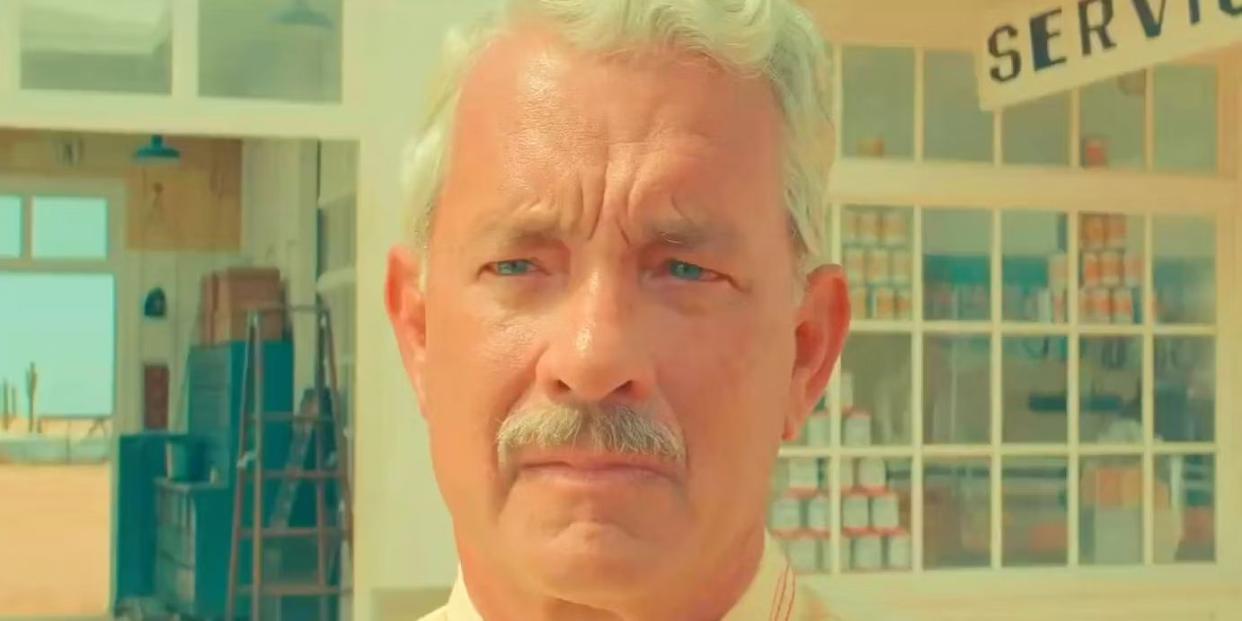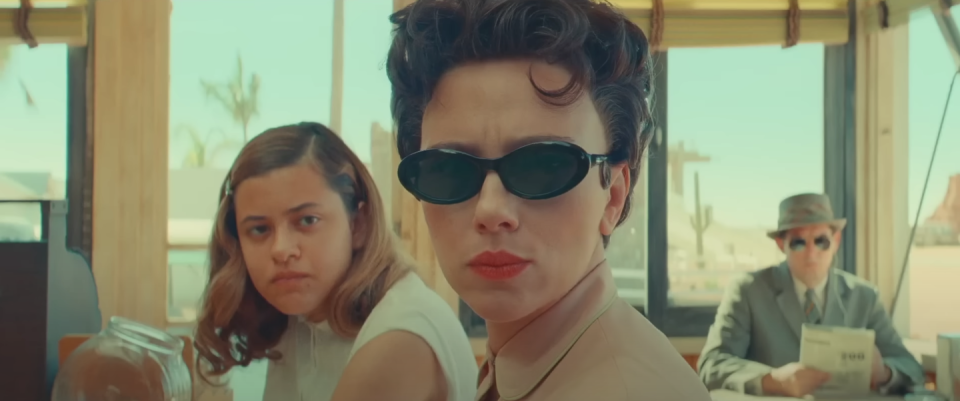'Asteroid City' Is Wes Anderson's Big-Hearted Masterpiece

- Oops!Something went wrong.Please try again later.
- Oops!Something went wrong.Please try again later.
Wes Anderson is a man of many loves. Among them, of course, are undersized suits, symmetrical compositions, and precocious children. But often overlooked is his love for lodging his stories in structural nesting dolls. He tends to frame them, for instance, as novels, remembrances, or magazines. These devices serve several functions: they’re nods to his inspirations, explanations for his aesthetic and narrative fabulism, and, sometimes, meta-commentary on the act of storytelling.
In Anderson’s latest film, the absolutely stellar Asteroid City—in theaters now—his container is both his most convoluted and the most fundamental to his underlying project. The film begins on a black and white 1955 television broadcast, with Brian Cranston’s Playhouse 90-esque host briskly explaining, “Tonight’s program takes us backstage to witness first-hand the creation, start to finish, of a new play mounted on the American stage.”
That play is Asteroid City. After introducing its author, Conrad Earp (Ed Norton), and the main cast, the movie bursts with magnificent, pastel-hued color, Johnny Duncan’s grainy skiffle tune “Last Train to San Fernando” comes galloping on, and we’re transported via freight train to Asteroid City, an 87-person desert town in the American Southwest.
Anderson, both the consummate sentimentalist and sensualist, delights in depicting—and, yes, embellishing—the iconic emblems of the West. Besides the freight train, there are roadrunners and tumbleweeds, Close Encounters-esque rock formations, a luncheonette serving bright pie and tall ice cream sundaes, and a motel with vending machines dispensing everything from martinis to land deeds. As cynical as modern audiences may be about America, it’s hard to resist being swept up in Anderson’s—or, rather, Earp’s—vision of it. (I’ll say it: Trains are cool!)
But we’re not in Asteroid City merely to marvel at all the midcentury Americana. The town is playing host to the Junior Stargazers Convention. Which is why Augie Steenbeck (an out-of-this-world Jason Schwartzman), a war photographer and recent widower, is here with his four children. His eldest, Woodrow (an equally fantastic Jake Ryan), is one of five young brainiacs being honored for their inventions—his is a device that projects images on the moon.
Augie, like all of the characters we meet in Asteroid City, is a role within a role. Schwartzman’s Jones Hall (a bohemian, James Dean type) dons a sturdy beard, is always squinting in the sun, and speaks in terse sentences, jaw clenched like Stanley Kubrick—all choices that reflect a form of postwar masculinity rooted in erecting walls and suppressing feelings. At first, when Augie casually uses a gas pump to ignite an empty lighter and smoke his cigarette, it all seems like classically cool and clever Andersonian affectation. But there’s a simmering sense of malaise drifting through the desert air, embodied foremost in Augie. Not just because he’s seen some things overseas. We soon learn that Augie’s wife died three weeks ago, and he still hasn’t told his children. “It’s always the wrong time,” his country club father-in-law (Tom Hanks) tells him over the phone. Which is to say: Just do it.
As their busted car is being repaired, Augie finally sits the kids down in the hot sand and breaks the news: Mom’s in the tupperware. Woodrow suspected it. The three young girls can’t fully get their heads around it. Since its nature is so internal and varied, grief is a hard thing to portray on screen—or on the stage, for that matter. Credit to Earp; his play doesn’t overdo it. There aren’t a lot of tears, nor talk of feelings. But also, credit to the actors: You can feel the weight of the loss, and sense them pushing it down. If anything, the reality of death provokes a quiet, sullen searching.
All the more so when—time for spoilers—the alien visits. This, I should say, is at the end of Act I, as all the kids and their parents are viewing the “Astronomical Ellipses” (...Wes) through mirrored cardboard box contraptions. A green glow engulfs the celestial punctuation, and everyone removes their box and watches as a lanky alien descends from a UFO… and snatches the town’s asteroid. Augie snaps a picture—which, naturally, the alien poses for. (Wes!!)
It’s a playful scene, and one that is, like much of this movie, very funny. But it’s also a turning point. Various characters have moments of earnest reflection; the visitation is something of an existential Rorschach. Augie worries that the alien looked at them “like we’re doomed.” Woodrow wonders if the existence of aliens indicates that there is indeed a meaning of life. One of the other young brainiacs (played by Aristou Meehand, with shades of Max Fisher) hypothesizes that he’s always wanting to be dared to do things because “I’m afraid no one will notice my existence.”

Offstage, the actors are similarly flailing for meaning. “I still don’t understand the play,” Schwartzman’s Jones Hall tells the director, Schubert Green (Adrien Brody, of course), after his character purposefully burns his hand on a Quicky-Griddle while flirting with movie star Midge Campbell (a note-perfect Scarlett Johansson).
“It doesn’t matter. Just keep telling the story,” Green responds.
For such a meticulous director, there’s a palpable sense that Anderson (along with co-writer Roman Coppola) is giving himself over to intuition in Asteroid City—not so much in his precise-as-ever blocking and immaculate set design, as in how he allows the story to unfold. Earp’s play may be divided into three acts, but Anderson takes a looser, more poetic approach to narrative, paying little mind to characters’ wants or any sort of classic hero’s journey. After all, life doesn’t move that way; we’re constantly feeling around in the dark, dreaming and waking. Brainiac or not, no matter how much you want to know the answers to the deepest mysteries of the universe, you probably won’t ever find them—or, for that matter, be satisfied by them. So, maybe what’s left is having fun, making art with your troupe, and moving through the world with the sort of spunk and wit that Anderson loves to instill in his child characters?
The movie’s emotional climax comes during a gut-wrenching scene backstage, in which Jones Hall vents his uncertainty to the character who would’ve played his wife had her scene not been cut—and then, in the play, when the children bury their mother for good. For me, the key to the movie occurs earlier—when the alien returns the asteroid and ecstatic chaos breaks out. The Junior Stargazers had previously been brainstorming the most meaningful symbol to project onto the moon, with Woodrow saying, “This is our chance to be actually worthwhile.” When the moment comes, rather than an American flag or a religious symbol, Woodrow projects a heart with his initials and his new girlfriend’s initials in it.
It’s played as a joke. But really, in the mad frenzy of life, what could be more beautiful and worthwhile than declaring your love to someone you’ve only known a week for all the universe to see?
You Might Also Like

